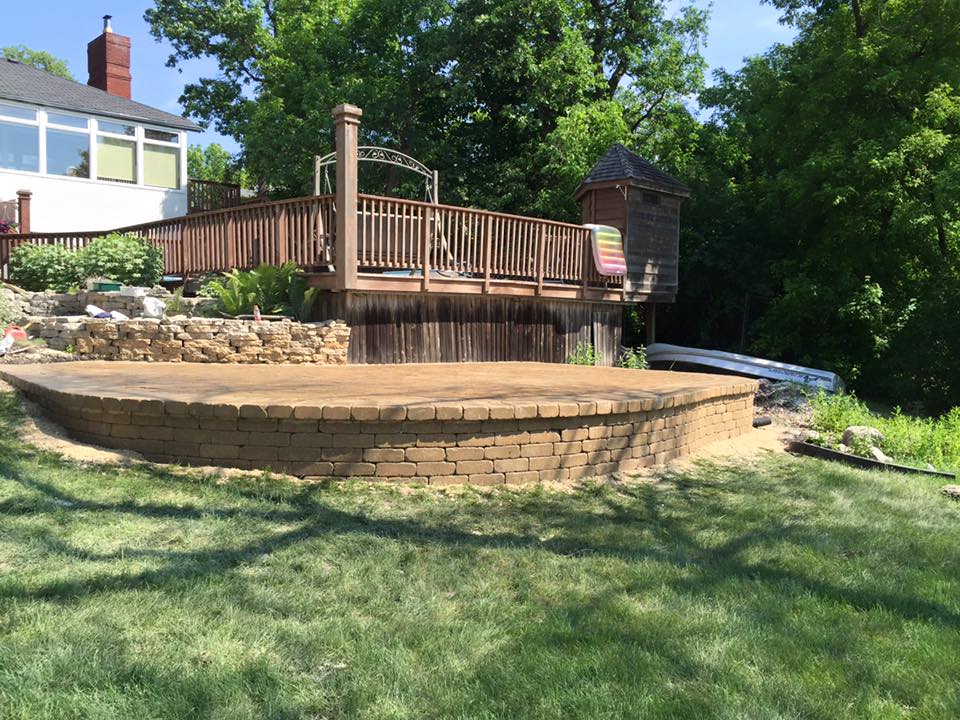Ask Brian is a weekly column by Real Estate Expert Brian Kline. If you have questions on real estate investing, DIY, home buying/selling, or other housing inquiries please email your questions to [email protected].

Question from Barb in WA: Hi Brian, We love our short summer in the northwest and want to make the most of getting together with friends and family in our backyard during the summer evenings and weekends. We love the modern amenities in our 4-year-old home but it has a postage stamp size backyard. What passes for a patio is an 8 ft. by 4 ft. cement slab that is a recessed alcove under the roofline so that the second floor of the house acts as a cover over the very small patio. I’m not sure how to explain better it but the walls are built around the patio with a sliding door going from a hallway leading to the garage, the sliding door is part of the wall in the hallway and the slider opens to the small patio. From the patio to the fence shared with our neighbor is about 12 ft. of grass. That same 12 ft. strip extends along the garage to a gate opening to the back alley. So, what we call our backyard is about 12 ft. by 25 ft. It’s so small that we don’t want to spend much money on the space but we would like to make it more appealing and functional for entertaining. Another problem we are dealing with is because our house and the neighbor’s house are two-stories tall, the sun only gets into the small outside area for about two hours even during the summer. The space cools down really fast in the evenings. Any ideas?
Answer: Hello Barb. I’ve lived in the Pacific Northwest for many years and understand how important the short summers are here. Although I’m not a fan of the modern postage stamp suburban yards, they are a reality. You’re not going to be setting up a croquet game or a volleyball game in that space, so I’m thinking a larger seating area with a BBQ would be a good choice; search Ranch and Home for bbq brands. Even sitting down, if you’re trying to social distance, you probably won’t be able to get more than 8 or 10 people in the space. But here are a few ideas.
Extending the cement slab to the fence line and all of the way to the back alley is one option. However, cement is permanent in that limited space, in case you ever want to do something different back there. There is also a good possibility of a local ordinance prohibiting a permanent structure (cement) all of the way to the fence line. A better answer is probably something temporary that you can remove relatively easily if you change your mind later.
An easy solution (and low cost) is extending the cement patio with a gravel patio. If you can, it should extend at the same level as the existing cement (without a step). You want the gavel to be at least 2 inches deep. You might need to dig out a couple of inches of dirt to get the right depth. The other thing that you want to do is create an edge around the gravel to keep it from going beyond the fence line. After you have the dirt at the right level, adding the edge should be as simple as nailing pressure treated 2” X 6” along the bottom of the fence. I recommend “below ground” pressure treated wood. Using 6” X “6” instead of 2” X 6” can give you a more professional looking border. Also, consider bordering the garage wall with pressure-treated wood. This is important if the siding on the garage wall goes all of the way to the dirt line. But this might not be necessary if there are several inches of cement foundation between the dirt line and the bottom of the siding. Next, I like to put down a vegetation barrier between the dirt and the gravel. The only thing remaining is to shovel in the gravel and level it with a garden rake. Find a gravel supplier that offers several types of natural gravel available that are decorative. Multi-color pea gravel is popular as is river run gravel. What’s important to many people is that the gravel has rounded edges that are easy on feet wearing sandals. I’d avoid gravel with sharp edges that happen when something like granite is crushed into gravel. Once you've chosen the type of gravel you're going to use, you can then hire a commercial dump truck service to deliver the gravel to your location.
Barb, there are other options you might want to consider. The Pacific Northwest is known for rain (even during the summer). You might want to think about putting down some small diameter perforated PVC drainpipe below the gravel to drain away rainwater. Another option is using paver stones instead of gravel. Paver stones triple your cost (or more) and have the required step of needing a layer of sand underneath. You also mentioned that it gets chilly out there in the evenings. If you have enough space between the house and the fence, you can consider adding an above-ground fire pit for warmth. Propane fire pits can be an option instead of a wood fire in confined areas.
With a little help from patio builders, you should be able to complete the entire project in one weekend before the end of June when the northwest summer actually gets started.
Please leave your comments about improving the functionality of a very small back yard.
Our weekly Ask Brian column welcomes questions from readers of all experience levels with residential real estate. Please email your questions or inquiries to [email protected].